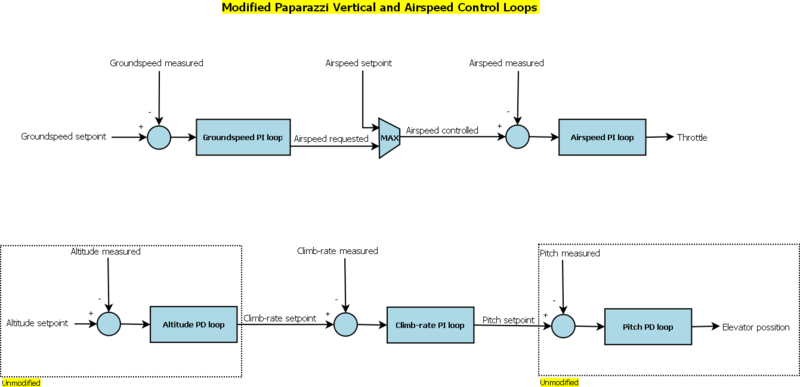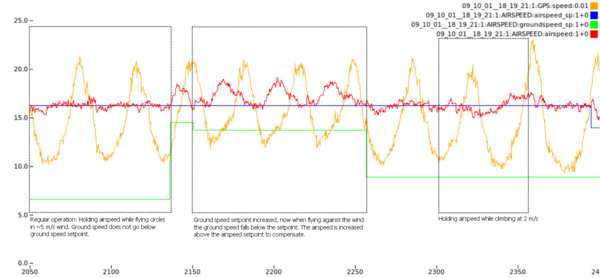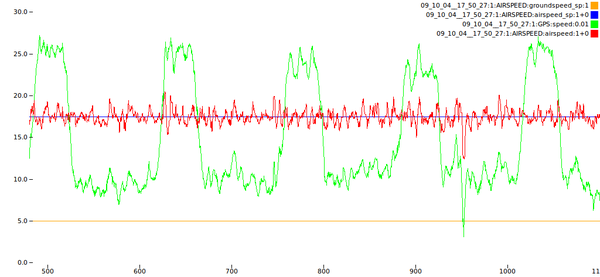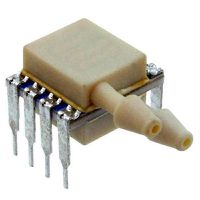Difference between revisions of "Sensors/Airspeed"
(→MS45xx: fix urls and prettify module load example) |
(→MS45xx) |
||
| (8 intermediate revisions by 4 users not shown) | |||
| Line 9: | Line 9: | ||
[[Image:Airspeed.png|left|800px]] | [[Image:Airspeed.png|left|800px]] | ||
<br style="clear:both"> | <br style="clear:both"> | ||
The following plot is from an actual test flight after spending some time setting the loop gains Here the possibility to perform real-time tuning through the GCS is a real time saver. In | The following plot is from an actual test flight after spending some time setting the loop gains Here the possibility to perform real-time tuning through the GCS is a real time saver. In the test, the an airplane was flying circles at a constant altitude, except in the end of the flight. The wind was about 5 m/s, judging from the ground speed variations. In the middle there is an example of what happens when the ground speed falls below the setpoint. Finally the altitude setpoint was changed to verify that the airspeed will be maintained while climbing. | ||
[[Image:PlotAS2.png|left|600px]] | [[Image:PlotAS2.png|left|600px]] | ||
<br style="clear:both"> | <br style="clear:both"> | ||
| Line 29: | Line 29: | ||
=== Connecting an EagleTree Airspeed Sensor === | === Connecting an EagleTree Airspeed Sensor === | ||
The [http://www.eagletreesystems.com/Standalone/standalone.htm EagleTree Airspeed Sensor] is a low cost module and comes with a very good pitot tube (Prandtl style, pitot-static tube) that includes static and dynamic ports. It has an [http://en.wikipedia.org/wiki/I²C I²C] interface that connects directly to the Autopilot I²C port. The paparazzi autopilot code is able to regulate the throttle in order to keep the airspeed constant (and a minimum ground speed). | The [http://www.eagletreesystems.com/Standalone/standalone.htm EagleTree Airspeed Sensor] is a low cost module and comes with a very good pitot tube (Prandtl style, pitot-static tube) that includes static and dynamic ports, it's resolution is 0.45 m/s and it's max speed is 156 m/s. It has an [http://en.wikipedia.org/wiki/I²C I²C] interface that connects directly to the Autopilot I²C port. The paparazzi autopilot code is able to regulate the throttle in order to keep the airspeed constant (and a minimum ground speed). | ||
When you buy the airspeed sensor it is set to operate in the default mode. Make sure you did not set it somehow to 3rd party mode. | When you buy the airspeed sensor it is set to operate in the default mode. Make sure you did not set it somehow to 3rd party mode. | ||
| Line 50: | Line 50: | ||
Optionally if you have a special requirement and want to use the ''direct mode'', it is possible. For this at the moment one needs to use the Eagletree software under Windows. [[Image:SetSensorFor3rPartyModeRealValues.jpg|240px]] | Optionally if you have a special requirement and want to use the ''direct mode'', it is possible. For this at the moment one needs to use the Eagletree software under Windows. [[Image:SetSensorFor3rPartyModeRealValues.jpg|240px]] | ||
This software runs fine under Linux Wine. The application is using the USB port in HID mode. Make sure your run Wine 2.0 or higher. | |||
== Sensortechnics Airspeed Sensor == | == Sensortechnics Airspeed Sensor == | ||
| Line 58: | Line 58: | ||
For airspeed measurements on low speed MAVs, a good choice is the [http://www.sensortechnics.com/en/products/pressure-sensors-and-transmitters/amplified-pressure-sensors/lba/ LBA series], especially the [http://www.sensortechnics.com/cms/upload/appnotes/AN_LBA_E_11162.pdf LBAS500UF6S]. | For airspeed measurements on low speed MAVs, a good choice is the [http://www.sensortechnics.com/en/products/pressure-sensors-and-transmitters/amplified-pressure-sensors/lba/ LBA series], especially the [http://www.sensortechnics.com/cms/upload/appnotes/AN_LBA_E_11162.pdf LBAS500UF6S]. | ||
This sensor can be used with the generic [http:// | This sensor can be used with the generic [http://docs.paparazziuav.org/latest/module__airspeed_adc.html '''airspeed_adc''' module]. Note that it may be necessary to use a divisor bridge to adapt the 5V output of the sensor to the 3.3V ADC input of the autopilot. | ||
== MS45xx == | == MS45xx == | ||
| Line 64: | Line 64: | ||
[[Image:MS4525DO.jpg|200px]] | [[Image:MS4525DO.jpg|200px]] | ||
A | A MS4525DO based sensor user could benefit from built-in temperature compensation. | ||
Application notes to accompany this product: | Application notes to accompany this product: | ||
| Line 91: | Line 91: | ||
Two MS5611 working in cooperation. see http://blueflyvario.blogspot.de/2013/06/air-speed-from-two-ms5611.html | Two MS5611 working in cooperation. see http://blueflyvario.blogspot.de/2013/06/air-speed-from-two-ms5611.html | ||
== [[Sensors/AMSYS|AMS 5812-0003 / AMS 5812-0001]]== | |||
[http://www.amsys.info/drucksensor/differenzdrucksensor.htm EU distributor] | |||
[http://www.servoflo.com/product-guide-downloads/low-pressure-guide/download/398/847/17.html US Distributor] | |||
Comes as sensor only and has a digital I2C and an analog 0.5 V - 4.5 V interface. At least two pull-up resistors (4.7 kOhm) and the wiring have to be added for I2C use. This can be done directly on the sensor and does not necessarily have to be on a special pcb. | |||
See [[Sensors/AMSYS|the sensor page]] for I2C addressing. | |||
The biggest advantage of the -0001 is its resolution, at a loiter airspeed of 8.5 m/s, the resolution of the -0001 is about 0,0038 m/s whereas the resolution of the MS4525 would be 0,082 m/s (using the data provided by 3DR). | |||
This advantage gets smaller, the faster the aircraft travels. At 25 m/s the resolution is about 0,0013 m/s and 0,028 m/s. Both resolutions should be more then enough at that speed. | |||
Maximum speed for the -0001 is about 41 m/s (0 ... 10.34 mbar), for the -0003 about 58 m/s (0 ... 20.68 mbar). | |||
= Future = | = Future = | ||
Just as with everything in the UAS world, lots of | Just as with everything in the UAS world, lots of improvements are still possible. | ||
'''What could be improved:''' | '''What could be improved:''' | ||
Latest revision as of 18:09, 5 August 2020
Introduction
By default, in the airborne code, airspeed is estimated by measuring the GPS ground speed. The related control loops are described here. This gives reasonable results particularly in calm weather conditions. Adding an airspeed sensor measures actual airspeed resulting in better throttle control and aircraft performance especially in windy conditions. It is possible to build your own airspeed sensor by using pressure sensors. To start with adding airspeed sensors it is easier to buy pre-build calibrated airspeeds sensors. This page is currently mainly about how to do just that.
How does it work internally
The altitude and airspeed loops are separated as shown in the diagram below. Basically the throttle and pitch are controlled independently and are not coupled in the control loops. Of course one affects the other but the control loops are independent. Please see the control loops for a more detailed block diagram. The airspeed is controlled by two cascaded Proportional–Integral (PI) loops. The first loop is used to regulate the ground speed and the second the airspeed. This is done just to ensure that if the ground speed drops below a certain value the airspeed will be increased to compensate in order to maintain a valid GPS heading. If you happen to have a 3axis magnetometer build in your airframe for getting the heading values, maintaining a certain GPS speed for getting a heading is not needed.
The following plot is from an actual test flight after spending some time setting the loop gains Here the possibility to perform real-time tuning through the GCS is a real time saver. In the test, the an airplane was flying circles at a constant altitude, except in the end of the flight. The wind was about 5 m/s, judging from the ground speed variations. In the middle there is an example of what happens when the ground speed falls below the setpoint. Finally the altitude setpoint was changed to verify that the airspeed will be maintained while climbing.
The benefits of the airspeed hold are obvious in this example. The throttle adjusts to keep the airspeed close to the setpoint.
Measuring
Sometimes it is very helpful for tuning your aircraft that you only measure the airspeed without controlling you aircraft behavior. This can be accomplished in the following way:
Replace the USE_AIRSPEED define with MEASURE_AIRSPEED. If you want to get sensor information as it is acquired without delay through the PERIODIC_SEND_ telemetry mechanism, please set SENSOR_SYNC_SEND instead. Note that defining MEASURE_AIRSPEED and not USE_AIRSPEED results in the normal AIRSPEED message containing rather useless information (it is simply four copies of estimator_airspeed, which is not updated by the airspeed sensor, though appears to be updated a very low rate FIX THIS?). Since the airspeed control loops are not active, one can vary the frequency of the raw measurements by adjusting the rate at which the airspeed_ets module is called in conf/modules/airspeed_ets.xml in the periodic function frequency.
Airspeed sensors
EagleTree Airspeed Sensor
Connecting an EagleTree Airspeed Sensor
The EagleTree Airspeed Sensor is a low cost module and comes with a very good pitot tube (Prandtl style, pitot-static tube) that includes static and dynamic ports, it's resolution is 0.45 m/s and it's max speed is 156 m/s. It has an I²C interface that connects directly to the Autopilot I²C port. The paparazzi autopilot code is able to regulate the throttle in order to keep the airspeed constant (and a minimum ground speed).
When you buy the airspeed sensor it is set to operate in the default mode. Make sure you did not set it somehow to 3rd party mode.
First, connect the sensor directly to the TWOG, Tiny or Lisa/M autopilot board via the I²C connector. The connector is J6 on the TWOG and Tiny and I2C on Lisa board. The wires coming from the sensor module have the following layout:
Red wire: 5V White wire: Ground Yellow wire: SDA Brown wire: SCL
See the airspeed_ets module page for configuration.
EagleTree sensor in 3rd party mode
While it is possible to use the sensors in a mode where values are the real values measured a.k.a. 3rd party mode, for regular use with the autopilot it has no specific advantage. Since the paparazzi already contain code to convert values to real speed values. Using the default setting is even a simpler if you have an eagletree logger and inbetween do some measurement with it, you do not need to reprogram the sensors if you connect them to the Autopilot board again.
Direct mode
Optionally if you have a special requirement and want to use the direct mode, it is possible. For this at the moment one needs to use the Eagletree software under Windows. 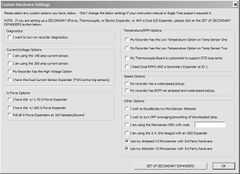
This software runs fine under Linux Wine. The application is using the USB port in HID mode. Make sure your run Wine 2.0 or higher.
Sensortechnics Airspeed Sensor
Sensortechnics provides a lot of solution for pressure measurements, absolute or differential, using analog or digital (i2c) outputs.
For airspeed measurements on low speed MAVs, a good choice is the LBA series, especially the LBAS500UF6S.
This sensor can be used with the generic airspeed_adc module. Note that it may be necessary to use a divisor bridge to adapt the 5V output of the sensor to the 3.3V ADC input of the autopilot.
MS45xx
A MS4525DO based sensor user could benefit from built-in temperature compensation.
Application notes to accompany this product:
- MS45xx Series Application Notes
- Interfacing to MEAS Digital Pressure Modules
- Configuration, POR and Power Consumption.
One can buy one here at digikey
To use MS4525 you can load the airspeed_ms45xx_i2c.xml module, e.g. put these lines in the modules section of your airframe file:
| File: conf/airframes/myplane.xml |
<modules>
<load name="airspeed_ms45xx_i2c.xml">
<define name="MS45XX_I2C_DEV" value="i2c1"/>
<define name="MS45XX_PRESSURE_RANGE" value="1"/>
<define name="MS45XX_OUTPUT_TYPE" value="0"/>
<define name="MS45XX_PRESSURE_OFFSET" value="8549.0"/> <!-- 8542.0-->
</load>
</modules>
|
Duo MS5611
Two MS5611 working in cooperation. see http://blueflyvario.blogspot.de/2013/06/air-speed-from-two-ms5611.html
AMS 5812-0003 / AMS 5812-0001
Comes as sensor only and has a digital I2C and an analog 0.5 V - 4.5 V interface. At least two pull-up resistors (4.7 kOhm) and the wiring have to be added for I2C use. This can be done directly on the sensor and does not necessarily have to be on a special pcb.
See the sensor page for I2C addressing.
The biggest advantage of the -0001 is its resolution, at a loiter airspeed of 8.5 m/s, the resolution of the -0001 is about 0,0038 m/s whereas the resolution of the MS4525 would be 0,082 m/s (using the data provided by 3DR). This advantage gets smaller, the faster the aircraft travels. At 25 m/s the resolution is about 0,0013 m/s and 0,028 m/s. Both resolutions should be more then enough at that speed.
Maximum speed for the -0001 is about 41 m/s (0 ... 10.34 mbar), for the -0003 about 58 m/s (0 ... 20.68 mbar).
Future
Just as with everything in the UAS world, lots of improvements are still possible.
What could be improved:
- Maybe revert to GPS measurements only if the airspeed sensor fails.
- Detect Swap of static/dynamic port at pre-flight test
